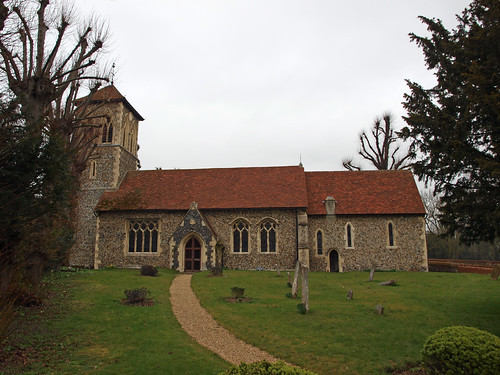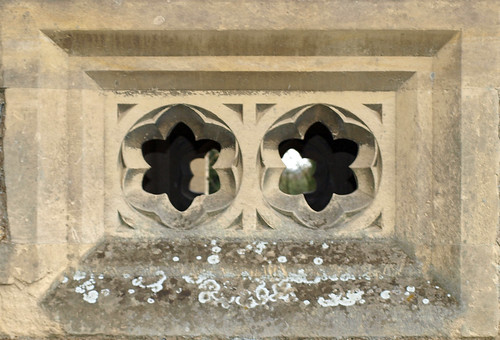ST MARGARET. Chancel C13, see some windows, especially the one high up in the E gable and the S window which is shafted inside. The rest of the church was built in 1858-9 and designed by John Hanson Sperling. - PLATE. Small Cup of 1571. - MONUMENT. J. S. Bradbury d. 1731, signed by H. Scheemakers. Relief scene flanked by volutes on the l. and r. showing Mr Bradbury rising up with open arms and cherubs above and beside him.
WICKEN BONHUNT. Its church, with a dainty spire, watches over a charming cottage group, with fine elms close by and Wicken Hall next door, an Elizabethan house with a handsome chimney stack. But those who come from Newport will pass an older shrine at Bonhunt Farm, a little Norman chapel with a roof of thatch. It was called St Helen’s, and is less than 40 feet long, its chancel only 10 feet wide. Here still are five Norman windows, one of them circular, a filled-up Norman doorway, a scratch dial close by, and a pillar piscina built into a window.
Nothing in the village church is quite so old as these simple walls, unless it be the rough square bowl of the font. But it has a 13th century chancel, and two of its old possessions are like those of the chapel, a scratch dial and a piscina. The chancel has also kept some of its lancet windows, a small seat for the priest, and a monument with a figure of a woman and cherubs in memory of little John Bradbury who died in 1693. He was the heir of his family, who lived not far away at Brick House, a handsome Tudor building with two imposing gables. A sculptured figure in Roman dress is at a corner of one of them, and a stone bust is over the entrance. With the house is a thatched barn of the 17th century.
Simon K -
Closed, converted into a community centre. An interesting story - this
is a bog standard little 19th Century church with few redeeming
features other than its delectable setting on a slope behind the
village pub, but in the 1850s the Vicar here was John Hanson Sperling,
who was an antiquarian and writer about the medieval churches of
Shropshire.
He tore down the old church and rebuilt it entirely to his own
designs. Unfortunately for us, this included destroying East Anglia's
most westerly complete round tower. 'Perhaps he thought he knew what
he was doing", writes James Bettley in the revised BoE, 'but the
result is lifeless, with surprising lapses - the chancel is lower than
the nave, there is no vestry (!) and there was a stove in the chancel
beside the priest's chair.' You can still see the chimney for the
last.
The furnishings have been dispersed except for the font and the altar, and the only thing of importance here, GF Bodley's banner for the Guild of St Margaret, is now on the wall at Arkesden, where I had photographed it that morning.
But this was a pleasant spot to sit and eat lunch in the full sunshine, before heading back towards Clavering and turning off on to a steep, steep narrow lane which climbed to the top of the ridge and I was the highest I had been all day. I could see the planes landing and taking off at Stanstead in the valley, some six miles away. The lane spiralled down and there, in the middle of nowhere, was Rickling parish church.
Flickr.


No comments:
Post a Comment